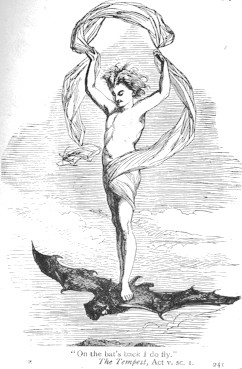Bats
Today, we meet some beleaguered animals that should be our friends. The University of Houston's College of Engineering presents this series about the machines that make our civilization run, and the people whose ingenuity created them.
Diane Ackerman writes books and poetry about the sensate world around us -- titles like A Natural History of the Senses. A sensate joy in the ambient world draws her, relentlessly, to the problem of preserving both her surroundings and the pleasure she finds in them. Take her article, "In Praise of Bats."
Saving a vanishing species, she points out, is a lot easier when the species is winsome like the panda. Pandas eat huge amounts of bamboo and convert it to manure. They're strongly woven into their ecology. Yet we're moved to save them, not for the good of the ecosystem, but because they're cute.
Then there are bats. Bats are mammals, not birds, and they come in a vast variety of species -- all the way from the bumblebee bat, the smallest known mammal, to the so-called flying fox with a wingspan that can reach six feet. Bat wings are actually long webbed fingers on the bat's forelimbs. Bats, who live 20 or 30 years, and breed only once a year, use those articulate, prehensile wings to cuddle their young.
Our mythology is hard on bats. And I don't just mean Dracula stories. Take the myth of rabies -- that bats carry rabies without being affected by it. That's simply false. Bats can catch rabies, but when they do, they soon die. Anyway, North American bats can hardly break our skin with their tiny teeth --they don't attack humans. Stand in the path of a flock and they'll pass by without touching you.
Still, until recently, public health officials egged on the extermination of bats. Communities, like peasants in Frankenstein movies, have carried torches into caves and burned out the bats. Many species have been exterminated and the rest are dwindling.
The irony lies in our huge debt to these harmless creatures. They are voracious eaters of insects. Kill off a local bat, who eats 600 mosquitoes a night, and the mosquitoes flourish. Bats repopulate certain forests by spreading seeds and pollinating plants. Guam's rain forests are under assault because Guamanians have hunted their fox bats for food until they're nearly extinct.
So read the record. Read about the balance of nature. Read about vampire bats who adopt orphaned baby bats, mate for life, and help out their friends. Read about cooperative coexistence.
A line pops out of Shakespeare's Tempest: "On a bat's back I do fly." Well, perhaps we really do, far more than we thought. But that's hard to see when we're corroded by nameless atavistic fears of these fragile coinhabitants of our fragile Earth.
I'm John Lienhard at the University of Houston, where we're interested in the way inventive minds work.
(Theme music)
Ackerman, D., The Moon By Whale Light. New York: Random House, 1991, Chapter 1, In Praise of Bats.
I am indebted to Margaret Culbertson, UH Art and Architecture Library, for recommending the Ackerman book and providing me with a copy. For more on Ackerman's A Natural History of the Senses, see Episode 955.
Toward the end of The Tempest, Ariel sings, while he helps to dress Prospero,
Where the bee sucks,
there suck I:
There I couch
when owls do cry,
On a bat's back
I do fly
After summer merrily.

Image from An Illustrated Shakspere Birthday Book, 1883

Representation of a Vampire Bat
From the 1832 Edinburgh Encyclopaedia